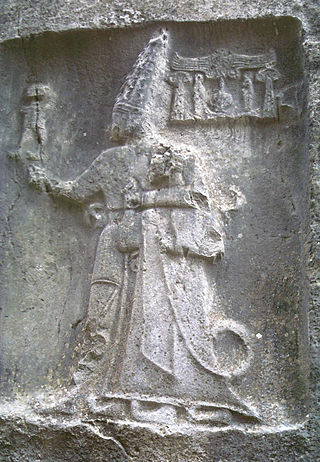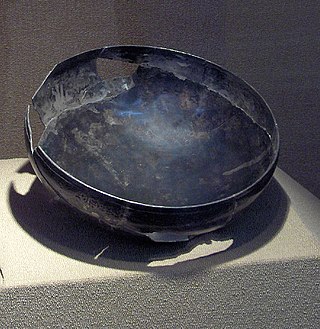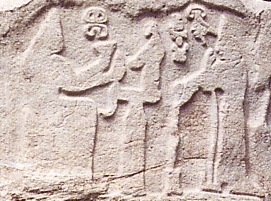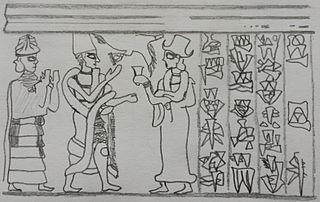
The Battle of Kadesh or Battle of Qadesh took place between the forces of the New Kingdom of Egypt under Ramesses II and the Hittite Empire under Muwatalli II at the city of Kadesh on the Orontes River, just upstream of Lake Homs near the modern Lebanon–Syria border.
Mursili I was a king of the Hittites c. 1620-1590 BC, as per the middle chronology, the most accepted chronology in our times,, and was likely a grandson of his predecessor, Hattusili I. His sister was Ḫarapšili and his wife was queen Kali.

Muwatalli II was a king of the New Kingdom of the Hittite empire c. 1295–1282 and 1295–1272 BC in the short chronology.
Tudhaliya I was a king of the Hittite Empire in c. the early 14th century BC.

Hattusili III was king of the Hittite empire c. 1275–1245 BC or 1267–1237 BC.
Mursili III, also known as Urhi-Teshub, was a king of the Hittites who assumed the throne of the Hittite empire at Tarhuntassa upon his father's death. He was a cousin of Tudhaliya IV and Queen Maathorneferure. He ruled ca. 1282–1275 BC or 1272–1265 BC.
Mursili II was a king of the Hittite Empire c. 1330–1295 BC or 1321–1295 BC.

Tudhaliya IV was a king of the Hittite Empire, and the younger son of Hattusili III. He reigned c. 1245–1215 BC or c. 1237–1209 BC. His mother was the great queen, Puduhepa.

Labarna I was the traditional first king of the Hittites, c. early 17th century BC, the most accepted chronology nowadays. He was the traditional founder of the Hittite Old Kingdom. His wife was Tawannanna.
Hattusili I was a king of the Hittite Old Kingdom. He reigned ca. 1650–1620 BCE, or ca. 1640–1610 BCE. Excavations in Zincirli Höyük, Southern Turkey, suggest that a complex there was destroyed in the mid to late 17th century BCE, possibly by Hattusili I in a military campaign, which could confirm the middle chronology dating for his reign. This destruction was recently radiocarbon-dated to sometime between 1632 and 1610 BCE. This event could have been part of Ḫattušili's campaign against Zalpa in order to disrupt an exchange network connected to Aleppo that previously linked the Euphrates, North Syria, and Central Anatolia. Aslihan K. Yener dates destruction of Level VII Palace at nearby Alalakh, located around 100 km southeast of Tilmen Höyük, in the second year of Hattusili's reign, 1628 BCE.

Puduḫepa or Pudu-Kheba was a Hittite queen, married to the King Hattusili III. She has been referred to as "one of the most influential women known from the Ancient Near East."

Kummuh was an Iron Age Neo-Hittite kingdom located on the west bank of the Upper Euphrates within the eastern loop of the river between Melid and Carchemish. Assyrian sources refer to both the land and its capital city by the same name. The city is identified with the classical-period Samosata, which has now been flooded under the waters of a newly built dam. Urartian sources refer to it as Kummaha. The name is also attested in at least one local royal inscription dating to the 8th century BCE. Other places that are mentioned in historical sources as lying within Kummuh are lands of Kištan and Halpi, and cities of Wita, Halpa, Parala, Sukiti and Sarita(?). Kummuh bordered the kingdoms of Melid to the north, Gurgum to the west and Carchemish to the south, while to the east it faced Assyria and later Urartu.
Gassulawiya was a Hittite queen of the king Mursili II, ruler of the Hittite Empire ca. 1321–1295 BC.

Kadašman-Enlil II, typically rendered dka-dáš-man-dEN.LÍL in contemporary inscriptions, meaning “he believes in Enlil” was the 25th king of the Kassite or 3rd dynasty of Babylon.
Yarim-Lim III was the king of Yamhad (Halab) succeeding Hammurabi II.
Hammurabi III was the king of Yamhad (Halab) succeeding Yarim-Lim III.

The Yamhad dynasty was an ancient Amorite royal family founded in c. 1810 BC by Sumu-Epuh of Yamhad who had his capital in the city of Aleppo. Started as a local dynasty, the family expanded its influence through the actions of its energetic ruler Yarim-Lim I who turned it into the most influential family in the Levant through both diplomatic and military tools. At its height the dynasty controlled most of northern Syria and the modern Turkish province of Hatay with a cadet branch ruling in the city of Alalakh.
This page is based on this
Wikipedia article Text is available under the
CC BY-SA 4.0 license; additional terms may apply.
Images, videos and audio are available under their respective licenses.








